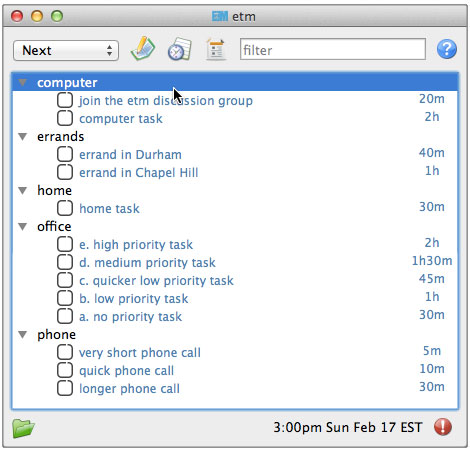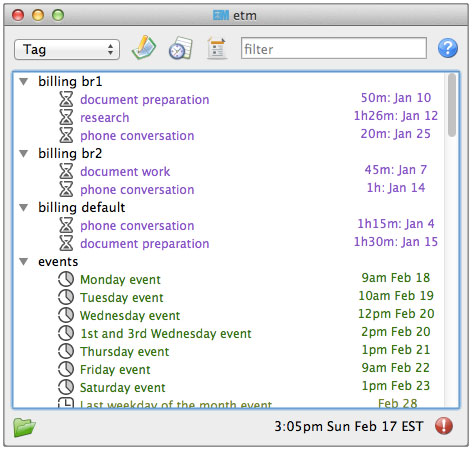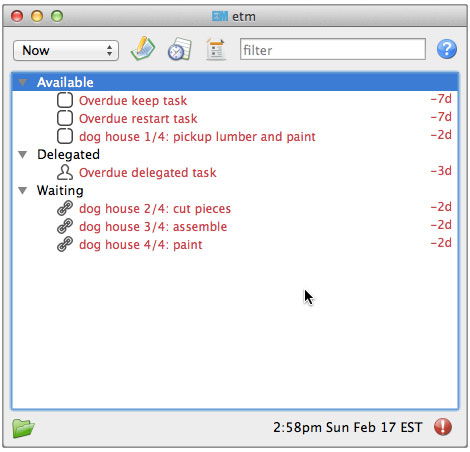
![]()
Etm, an acronym for “Event and Task Manager,” is a very useful calendar and planning tool. However, it is a bit cumbersome to learn and far less convenient to use than alternatives.It has an intuitive task-entry format, once you learn its plain text shorthand. Etm stores events, tasks and other user-generated notes and data in text files. You can create, modify and view entries using two primary methods.

The command line option is more suited to users with a flare for Unix-style applications on the Linux desktop. Most other users no doubt will find the cross-platform PyQT-based GUI a more workable option.
This GUI method is not the point-and-click approach provided by simple calendar and To-Do list apps, though. It involves pressing keyboard combinations and entering text in a second window using shortcut notations that display in the main calendar view when saved.
The latest version, dubbed “The Second Generation,” is Etm_qt-2.3.2, released on Feb. 3. It is a project associated with economics professor Daniel Graham at Duke University.
Interesting Concept
Etm is not a calendar or day planner tool for casual users. Its usefulness far exceeds the convenience available in Google Calendar or the event planner apps typically bundled in various Linux distro repositories.
The trade-off involves spending considerable time learning the cheat sheet entry shortcuts provided with the documentation. The flexibility Etm offers, however, easily can make up for the needed learning curve if you have a full schedule of events and planning items to track and schedule.
For example, you can display items grouped by year, month, day, week number, quarter, context, keyword, location, user, file or task priority. The display shows the number of items and time totals broken down by group headings. You also can see a list of busy and free times.
Perhaps two of the most essential features are Etm’s ability to set alarms for events, and its ability to set repeating reminders for both events and tasks in a variety of ways.
Getting It
Besides the somewhat arcane event-entry process, actually installing Etm can be a bit of a challenge. This project is available only in archived formats — zip and tar.gz. The installation process requires manual commands in a terminal window, even to execute the easy-install option.
You can install Etm using one of three methods. The first involves Python installation using PIP. You probably will first have to download the collection of Python tools specified in the directions. This approach clearly is not for the uninitiated, as it involves a series of compiling commands.
The second approach is the easy-install method. This is a simpler way to go. It involves opening a terminal window and issuing the command: sudo easy_install -U etm_qt. This method worked well for me — but it was not without some missteps along the way.
The third installation routine involves downloading and running the setup.py package. I found this method required too many steps along the way.
Why Use It?
Even after succeeding at the very user-unfriendly installation process, learning to use the abbreviated text-entry interface presents another user challenge. This process is not difficult, but it is format-specific. Once you learn it, though, creating and editing entries in Etm becomes much more intuitive.
The features this calendar and event planner project provides could be far superior to whatever you are using now. The emphasis here is on giving yourself a better event management tool.
Some of my favorites features in Etm are the ability to color code monthly calendar dates to reflect scheduled time and Etm’s flexible, ledger-style reports of time spent, suitable for client billing. I also like its ability to run regular expression searches and filters by title, context, keyword or project. Plus, Etm keeps a record of task completion dates.

Two more killer features are very must-have. The Date Calculator computes the number of days between two dates, or the date that results from adding a number of days to a date. The other is the Goto links to related files and URLs with hot keys.
Task Terminator
Etm is designed around the notion that it is easier to get things done if you can better manage the process. That “Getting Things Done” notion is actually an action management method bearing the same name as a book by David Allen.
Given the complete compilation of all the pieces to projects and tasks, the user’s mind can efficiently perform the task instead of getting bogged down in remembering all the details. Etm’s process approach addresses the three phases of good event management.
It focuses on a short-cut method of using text entries to store and organize the planning stage. It displays only the essential information needed for a scheduled task to facilitate the action step. The software makes it easy to check on the status of all project items for a successful review phase.
Rubric Rules
My only concern with using the software is having to really study the abbreviated plain language entry process. It is more like shorthand than plain text. I extracted these examples from the instruction guide that accompanies the archived download of Etm.
For example, here is the format for entering a simple task:
– pay bills @s Oct 25
This is how you enter a task group in which the individual jobs must be finished in @q (queue) order. In this case, the project is building a tree house for the kids:
+ tree house
@j pickup lumber and paint &q 1
@j cut pieces &q 2
@j assemble &q 3
@j paint &q 4

Using It
Linux app developers who insist on requiring command line execution to start a program have an elitist attitude that hinders the adoption of the Linux OS for mainstream use. As good as Etm is in managing events for the user, it is a perfect example of how some applications can convince new users that Linux is not easy to use.
You start Etm using this command: etm_qt [arguments] in a terminal window. You can skip the arguments if you want the program to use settings from the configuration file ~/.etm/etm.cfg .
To create a new item, click on the new item button or press Control-N. This opens an edit window for the entry. Then type the “coded” not-so-plain-text entry. When done, click the Save Icon or press Control-S to save your entry and choose a file from the dialog.
Etm offers several views besides this current-day display. Other calendar views are folder, next, now, tag and week.
Use the week view to find a free period and then double-click on the desired date and time. The editor will open with the date and time you selected already entered.
To create a new action from any GUI display, either click on the new action button or press Control-T to create a new action timer.
Bottom Line
Etm carries out its designed purpose well. However, learning to use its event entry structure keyboard shortcuts in the GUI can be challenging. Etm is not available as an easy-to-install distro package. This adds to the sometimes frustrating process of manually installing it.
If your workflow needs demand a flexible, top-notch application to organize, schedule and track your projects, though, Etm could be a very good solution. Just do not try it out on a mission-critical task before learning how to use it.





















































